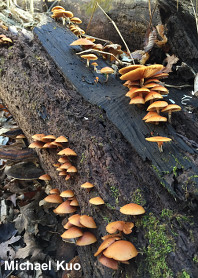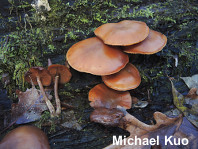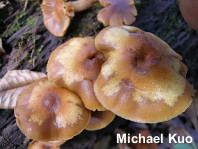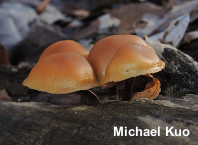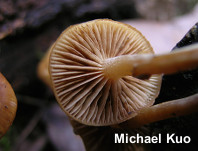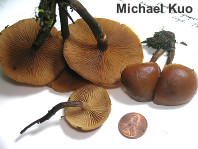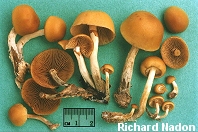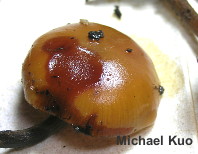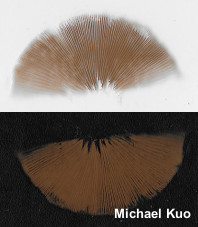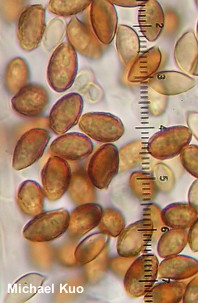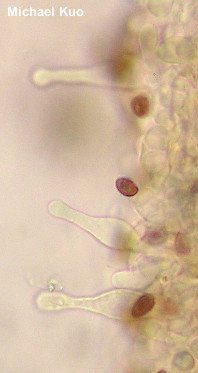| Major Groups > Gilled Mushrooms > Dark-Spored > Galerina marginata |

|
Galerina marginata [ Basidiomycota > Agaricales > Strophariaceae > Galerina . . . ] by Michael Kuo Among species of Galerina, most of which are tiny moss inhabiters requiring a microscope for identification, Galerina marginata is fairly distinct. Crucial identifying features include: Potential look-alikes include, depending on your familiarity with mushrooms, species of Armillaria (with a white spore print), Pholiota (spore print dark brown rather than rusty brown, cap often scaly), and the wood-inhabiting species of Hypholoma (generally larger, spore print dark brown to purplish brown). Galerina marginata can be found just about any time during the year, though it is more frequent, in temperate areas, anyway, in the spring and fall. This mushroom appears in older field guides as "Galerina autumnalis," but a 2001 DNA study (Gulden and collaborators) has synonymized that species—along with Galerina oregonensis, Galerina unicolor, and Galerina venenata—with the older, European species first described in the 18th century, Galerina marginata. Description: Ecology: Saprobic on the rotting wood of fallen hardwoods and conifers (in the Midwest, often but not exclusively found on the deadwood of eastern cottonwood); causing a stringy white rot; usually growing in clusters, but occasionally growing gregariously or alone; most frequent in spring and fall, but found year-round; widely distributed and common in North America. The illustrated and described collections are from Illinois, Colorado, and Québec. Cap: 1.5–5 cm (rarely up to 8 cm); convex at first, becoming broadly convex or nearly flat—or, sometimes, slightly bell-shaped; sticky when fresh or wet, otherwise tacky to dry; bald; at first honey yellow with an orangish hue, becoming cinnamon to brownish orange; often fading markedly as it dries out, creating a two-toned appearance; the margin sometimes adorned with whitish veil remnants when very young, usually becoming naked and finely lined at maturity. Gills: Broadly attached to the stem or just beginning to run down; close or nearly distant; short-gills frequent; yellowish at first, eventually becoming rusty brown or brownish as the spores mature; not bruising but sometimes becoming spotted in appearance in old age; at first covered by a whitish partial veil. Stem: 2–7.5 cm long; 3–8 mm thick; more or less equal; dry; bald or, when fresh and young, flecked with whitish fibrils; usually featuring a thin, whitish to rusty brown, collapsed, bracelet-like ring but sometimes with only a ring zone or without veil remnants at all; whitish to brownish, turning dark brown to reddish brown from the base up; basal mycelium white. Flesh: Insubstantial; yellowish to watery brownish; unchanging when sliced. Odor: Not distinctive, or slightly mealy (crush the flesh between your fingers). Chemical Reactions: KOH red to dull red on cap surface. Ammonia negative on cap surface. Iron salts negative on cap surface. Spore Print: Rusty brown. Microscopic Features: Spores 7–11 x 4–6 µm; broadly amygdaliform to subellipsoid; verrucose; reddish brown in KOH; often with a loosening perispore. Basidia usually 4-sterigmate, but occasionally 2-sterigmate. Pleurocystidia and cheilocystidia similar; 40–65 x 5–15 µm; lageniform, with a long neck and a rounded or subclavate apex; smooth; thin-walled; hyaline in KOH. Pileipellis an ixocutis. Clamp connections present. REFERENCES: (Batsch, 1789) Kühner, 1935. (G. autumnalis: Peck, 1872; Murrill, 1917; Smith & Singer, 1964; Smith, Smith & Weber, 1979; Arora, 1986; Phillips, 1991/2005; Lincoff, 1992; Metzler & Metzler, 1992; Horn, Kay & Abel, 1993; Barron, 1999; Breitenbach & Kränzlin, 2000; Roody, 2003; Miller & Miller, 2006. G. marginata: Saccardo, 1887; Smith & Singer, 1964; Smith, Smith & Weber, 1985; Breitenbach & Kränzlin, 2000; Gulden, Dunham & Stockman, 2001; Gulden et al., 2005; McNeil, 2006; Kuo, 2007; Trudell & Ammirati, 2009; Gulden, 2010; Kuo & Methven, 2014; Desjardin, Wood & Stevens, 2015; Evenson, 2015.) Herb. Kuo 05149501, 04309601, 04309602, 03120301, 03150302, 10280403, 04110801, 12161501. Herb. DBG RMNP 2009-055, ROMO 2012 5023-35. This website contains no information about the edibility or toxicity of mushrooms. |
© MushroomExpert.Com |
|
Cite this page as: Kuo, M. (2016, July). Galerina marginata. Retrieved from the MushroomExpert.Com Web site: http://www.mushroomexpert.com/galerina_marginata.html |
